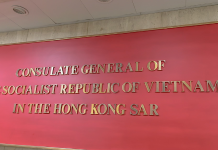Before the railway was electrified in 1983, Sheung Shui was seen as a backwater. Minibuses and diesel trains were the only public transport available.
“The train ride lasted for at least one hour from Mong Kok… and each train came every other hour, so when you missed one, you had to sit at the station for a long time. It was very inconvenient,” says by Wong Chi-wah, the former district councillor for Shek Wu Hui constituency and a retiree who has lived in Sheung Shui for 40 years.
When Wong Chi-wah first moved to the area, the border between Sheung Shui and Shenzhen was simply separated by wire fences and gates. Residents from both sides of the border travelled easily back and forth. Residents recall that farmland near the border was shared between Sheung Shui and Shenzhen farmers and the two groups of people got along very well.
However, after years of development, most of this farmland has been replaced with commercial and residential buildings. While he rues the loss, Wong Chi-wah says that “we can’t always have rural villages… sacrifices have to be made for society to develop.”
Wong thinks the electrification of the railways played a pivotal role in transforming Sheung Shui from a rural backwater into an urban new town. The development of Lo Wu station and the opening of the line from Sheung Shui to Lok Ma Chau in 2007 further encouraged greater interaction and integration with the mainland.
The population, which shot up from 10,900 in 1986 to around 220,000 now, has largely contributed to the development of the area.
The first big wave of development and urbanization in Sheung Shui actually took place in the early 1980s when the first public housing estate, Choi Yuen Estate, was built. Later, Home Ownership Scheme flats like Yuk Po Court, Choi Po Court and other estates were also built, further expanding the population.
But unlike the current reaction to the transient mainland traders and visitors in Sheung Shui, this wave of urban newcomers does not appear to have encountered much opposition.
The difference, for old-timers like Wong Chi-wah, is that today’s scenario feels like an intrusion. Like the protesters calling on residents to “Reclaim Sheung Shui”, Wong Chi-wah thinks there are not enough hospital beds for pregnant local women, since mainland mothers started to travel to the town to give birth. School places are also limited since mainlanders want their children to be educated in Sheung Shui and there is even competition for daily necessities such as milk powder.
“If a well has unlimited water, then we could share it with outsiders, with other residents, with tourists. No problem. But problems will occur if we only have a barrel of water, we do not even have enough water for ourselves and we have to share it with other people,” says Wong.
But for the current district councillor, Simon Wong, the idea of an “intrusion” in Sheung Shui does not make sense, whether it was 30 years ago or today. “You have your own living space and activity space,” he says. “The influx of people is an inevitable phenomenon of social development.”
Despite the drastic changes that have taken place in Sheung Shui in recent years, it has retained some of its distinct local character and businesses. Most of these are centred in and around Shek Wu Hui, which has been the site of a market serving the villages in the Sheung Shui area since before the development of the new town.






































